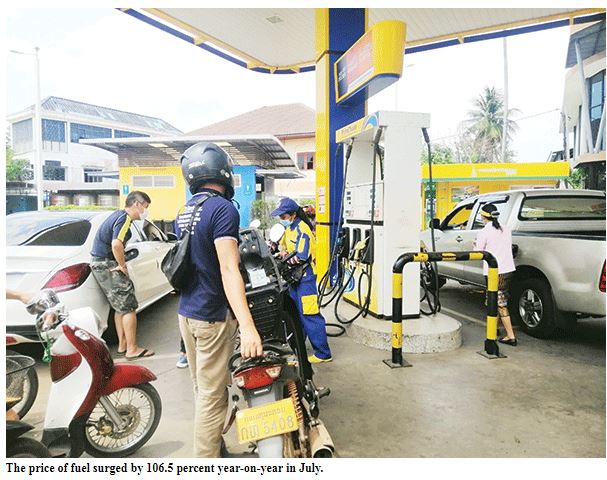Inflation in Laos jumps to 25.6 percent in July
The year-on-year inflation rate jumped to 25.6 percent in July, up from the 23.6 percent recorded in June, according to the latest report from the Lao Statistics Bureau.
This is the highest figure ever recorded since 2000, causing further hardship for low-income earners as they struggle to cope with the spiralling cost of living.
The price of food, medical care, transport and consumer goods has all surged significantly in recent months.
The soaring price of fuel and other imported goods, compounded with the depreciation of the kip, are among the main factors driving inflation, according to the Lao Statistics Bureau.
The kip continues to depreciate despite the government’s attempts to regulate currency exchange rates.
The weak kip is the root cause of the problem as most businesses base the price of their products on foreign currencies, notably the Thai baht and US dollar.
Apart from the high cost of imported goods, higher fuel prices have driven up production costs, making almost everything more expensive.
Laos has one of the highest inflation rates in Southeast Asia, largely because the country imports more than it exports. The growing demand for the foreign currencies needed to import goods and repay debts is causing the kip to weaken further.
In addition, some crop yields tend to fall in the wet season, causing a shortage of supply and affecting market prices.
However, the government has pledged to provide sufficient petrol to meet the public’s needs and prevent further damage to the economy.
In July, the cost of food and non-alcoholic beverages increased by 5.2 percent month-on-month and 21.6 percent year-on-year, according to the Lao Statistics Bureau.
The price rise in this category was driven by the higher price of rice, which surged by 20.7 percent year-on-year. The cost of pork rose by 24.9 percent year-on-year, the cost of poultry rose by 22.5 percent, and eggs, cheese and milk went up by 35.9 percent.
Meanwhile, costs in the communications and transport category rose by 1.1 percent month-on-month and 53.2 percent year-on-year. Specifically, the price of fuel and vehicle and transport equipment went up by 106.5 percent, 54.3 percent and 63.7 percent year-on-year respectively.
The cost of medical care and medicines increased by 8.7 percent month-on-month and 37 percent year-on-year. The cost of medicines jumped by 40.8 percent, driving up prices in this category.
Prices in the hotel and restaurant category rose by 19 percent, driven by the higher cost of cooked food.
In the meantime, prices in the goods and service category rose by 25.6 percent year-on-year while the cost of household goods increased by 22.4 percent year-on-year.
In addition, the cost of clothing and footwear surged by 16.9 percent year-on-year, with the price of women’s clothing increasing by 17.8 percent and children’s clothes by 16 percent.
Source: https://www.vientianetimes.org.la/freeContent/FreeConten152_Inflation_y22.php


 English
English




